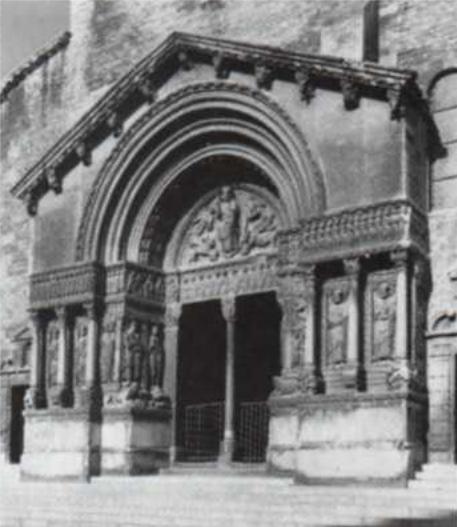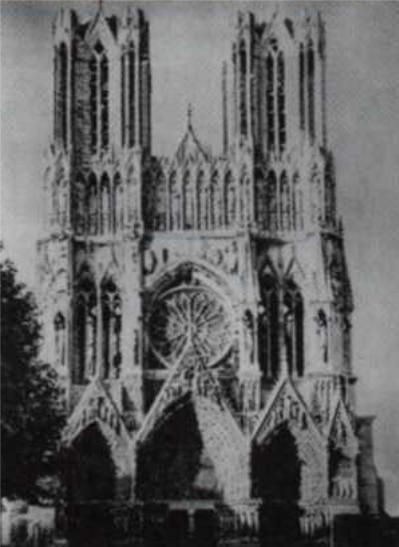
- •Before you read
- •1. Discuss the following questions:
- •2. Comment on the quotations. Do you agree with them? Explain your answers.
- •3. Read and translate the text. The Birth of Art
- •Glossary
- •Activities
- •1. Answer the questions to the text.
- •2. Look at the picture of «Venus of Willendorf». Describe it and answer the questions, use the cloud of clues or click on the link to read the Wikipedia article.
- •3. Translate the sentences from English into Russian.
- •4. Retell the text according to the plan:
- •Before you read
- •1. Discuss the following questions:
- •2. Mark the periods of Greek art and Roman art on the timeline.
- •3. Read and translate the text. Greece: they invented a lot more than the Olympics
- •Rome: the organizers
- •Glossary
- •Activities
- •1. Answer the questions to the texts.
- •Начало формы
- •5. Translate the sentences from English into Russian.
- •6. Retell the text according to the plan:
- •Before you read
- •1. Discuss the following questions:
- •2. Fill in the gaps in the chart below.
- •3. Read and translate the text. Medieval art
- •Glossary
- •Activities
- •1. Answer the questions to the texts.
- •2. Read the sentences about medieval art and fill in the gaps with the appropriate words or phrases.
- •3. Translate the sentences from English into Russian.
- •4. Retell the text according to the plan:
- •Before you read
- •1. Discuss the following questions:
- •2. Look at the map and describe the countries where the Renaissance started and took place, main artists and their masterpieces.
- •3. Read and translate the text. The Renaissance
- •The Early Renaissance
- •The Italian Renaissance
- •Glossary
- •Activities
- •1. Answer the questions to the texts.
- •2. Translate the sentences from English into Russian.
- •3 . Look at the two paintings. Compare them, use the words and phrases from the text.
- •4. Retell the text according to the plan:
- •5. Find the answer to the crossword puzzle.
- •Before you read
- •1. Discuss the following questions.
- •2. Comment on the quotations. Do you agree with them? Explain your answers.
- •3. Read and translate the text. The Northern Renaissance
- •The German Renaissance
- •Mannerism and the late Renaissance
- •T he Spanish Renaissance
- •Glossary
- •Activities
- •1. Answer the questions to the texts.
- •2. Translate the sentences from English into Russian.
- •3. Look at the pictures. Discuss the following questions.
- •5. Retell the text according to the plan:
- •Before you read
- •1. Discuss the following questions:
- •3. Read and translate the text. Baroque art
- •Italian Baroque
- •Flemish Baroque
- •Dutch Baroque
- •Glossary
- •Activities
- •1. Answer the questions to the texts.
- •2. Translate the sentences from English into Russian.
- •4. These sentences summarize the distinctive features of Baroque style. Decide which of them are true or false.
- •5. Retell the text according to the plan:
- •Before you read
- •1. Discuss the following questions:
- •2. Look at the chart and describe the difference between in Baroque style in these countries. Add your own examples of artists, sculptors and architects and their artworks.
- •3. Read and translate the text. English Baroque
- •Spanish Baroque
- •French Baroque
- •Glossary
- •Activities
- •1. Answer the questions to the texts.
- •2. Look at the picture. Whose artwork is it? Discuss these questions.
- •5. Translate the sentences from English into Russian.
- •3. The diagram below asks you to connect each genre of painting (center) with its correct description and example. An example has been provided.
- •5. Retell the text according to the plan:
- •Before you read
- •1. Discuss the following questions:
- •2. Look at the chart and make up your own sentences to describe the period of Neoclassicism. Give the examples of artists and their paintings.
- •3. Read and translate the text. Neoclassicism
- •American Neoclassicism
- •Glossary
- •Activities
- •1. Retell the text according to the plan:
6. Retell the text according to the plan:
Greek art.
Roman art.
Differences between Greek and Roman art.
Unit3
Medieval art: THE REIGN OF RELIGION

Before you read
1. Discuss the following questions:
How long was the period of Middle Ages?
Why is it called an epoch of religion?
What changed in the art during this period?
What famous paintings and sculptures dated to the period do you know?
How would you describe the distinctive features of medieval art?
2. Fill in the gaps in the chart below.
ART OF THE MIDDLE AGES |
|||
|
Byzantine |
Romanesque |
Gothic |
Art |
Mosaics, icons |
Frescoes, stylized sculpture |
Stained glass, more natural sculpture |
Architecture |
Central – dome church |
Barrel – vaulted church |
Pointed – arch cathedral |
Example |
|
|
|
Date |
|
|
|
Place |
|
|
|
3. Read and translate the text. Medieval art
The Middle Ages included the millennium from the fifth to the fifteenth century, roughly from the fall of Rome until the Renaissance. During its initial period, called the Dark Ages, barbarians destroyed what had taken 3,000 years to build. But there were many bright spots in art and architecture.
Since the Christian focus was on salvation for a glorious afterlife, interest in realistically representing objects of the world disappeared. Nudes were forbidden, and even images of clothed bodies showed ignorance of anatomy. The Greco-Roman ideals of harmonious proportions and balance between the body and mind ceased to exist. Instead, medieval artisans were interested exclusively in the soul. Art became the servant of the church.
Medieval art was composed of three different styles: Byzantine, Romanesque, and Gothic.
B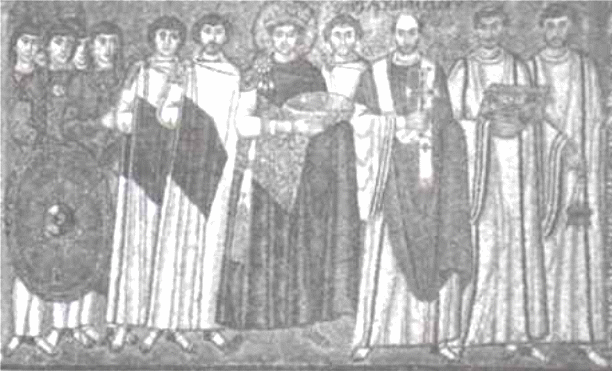 yzantine.
Byzantium was the center of a brilliant civilization combining early
Christian art with the Greek Oriental taste for rich decoration and
color. Some of the world's greatest art,
in the form of mosaics, was created during the fifth and sixth
centuries. Mosaics were intended to publicize the now–official
Christian creed, so their subject was generally religion with Christ
shown as teacher and all–powerful ruler. Human figures were flat,
stiff, and symmetrically placed, seeming to float as if hung from
pegs. Artisans had no interest in suggesting perspective or volume.
Tall, slim human figures with almond–shaped faces, huge eyes, and
solemn expressions gazed straight ahead, without the least hint of
movement. Although drawing on the Roman tradition of setting colored
cubes, or tesserae, in plaster to form a picture, Byzantine mosaics
were distinct from Roman.
yzantine.
Byzantium was the center of a brilliant civilization combining early
Christian art with the Greek Oriental taste for rich decoration and
color. Some of the world's greatest art,
in the form of mosaics, was created during the fifth and sixth
centuries. Mosaics were intended to publicize the now–official
Christian creed, so their subject was generally religion with Christ
shown as teacher and all–powerful ruler. Human figures were flat,
stiff, and symmetrically placed, seeming to float as if hung from
pegs. Artisans had no interest in suggesting perspective or volume.
Tall, slim human figures with almond–shaped faces, huge eyes, and
solemn expressions gazed straight ahead, without the least hint of
movement. Although drawing on the Roman tradition of setting colored
cubes, or tesserae, in plaster to form a picture, Byzantine mosaics
were distinct from Roman.
ROMAN MOSAICS |
BYZANTINE MOSAICS |
Used opaque marble cubes |
Used reflective glass cubes |
Pieces had smooth, flat finish |
Surfaces left uneven so work sparkled |
Colors limited due to use of natural stones |
Glowing glass in wide range of colors |
Typically found on floor of private homes |
Found on walls and ceilings – especially church dome and apse |
Subjects were secular, like battles, games |
Subjects were religious, like Christ as shepherd |
Used minute pieces for realistic detail |
Large cubes in stylized designs |
Background represented landscape |
Background was abstract: sky–blue, then gold |
R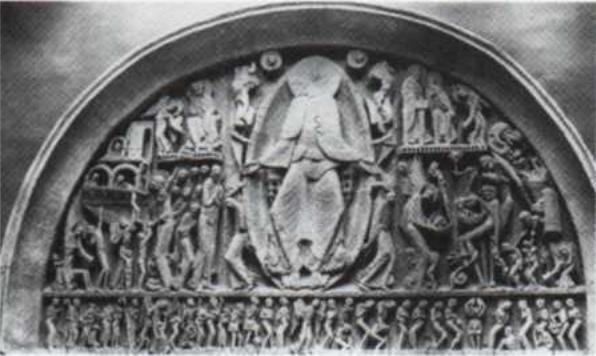 omanesque
art: stories in stone. With the Roman
Catholic faith firmly established, a wave of church construction
throughout feudal Europe occurred from 1050 to 1200. Builders
borrowed elements from Roman architecture, such as rounded arches
and columns, giving rise to the term Romanesque for the art and
architecture of the period. The exterior of Romanesque churches was
rather plain except for sculptural relief around the main portal.
Since most churchgoers were illiterate, sculpture taught religious
doctrine by telling stories in stone. Sculpture was concentrated in
the tympanum, the space beneath the arch and above the lintel of the
central door.
omanesque
art: stories in stone. With the Roman
Catholic faith firmly established, a wave of church construction
throughout feudal Europe occurred from 1050 to 1200. Builders
borrowed elements from Roman architecture, such as rounded arches
and columns, giving rise to the term Romanesque for the art and
architecture of the period. The exterior of Romanesque churches was
rather plain except for sculptural relief around the main portal.
Since most churchgoers were illiterate, sculpture taught religious
doctrine by telling stories in stone. Sculpture was concentrated in
the tympanum, the space beneath the arch and above the lintel of the
central door.
B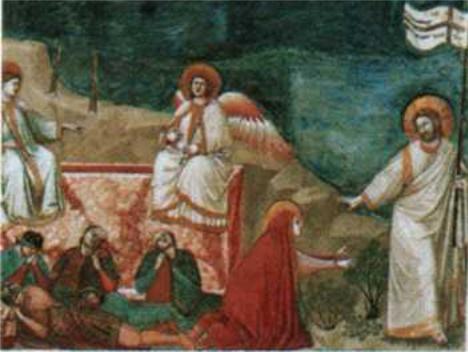
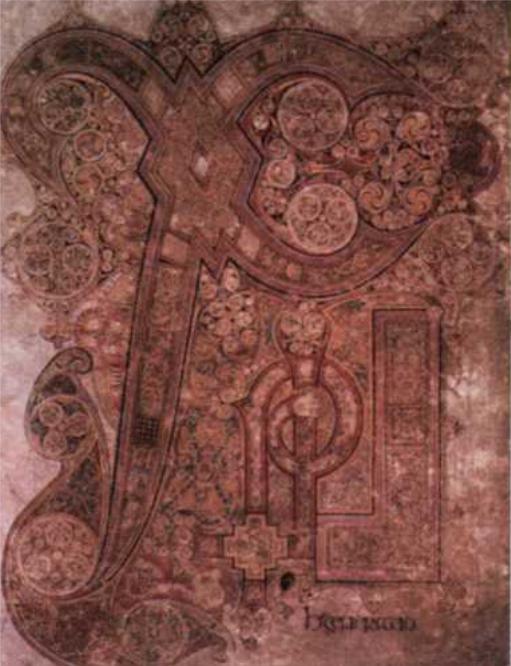 ecause
Italy maintained contact with Byzantine civilization, the art of
painting was never abandoned. At the end of the 13th century a
flowering of technically skilled painting occurred, with masters
like Giotto of Florence breaking with the frozen Byzantine style for
softer, more lifelike forms. The frescoes (paintings on damp plaster
walls) of Giotto di Bondone (1266–1337) were the first since the
Roman period to render human forms suggesting weight and roundness.
ecause
Italy maintained contact with Byzantine civilization, the art of
painting was never abandoned. At the end of the 13th century a
flowering of technically skilled painting occurred, with masters
like Giotto of Florence breaking with the frozen Byzantine style for
softer, more lifelike forms. The frescoes (paintings on damp plaster
walls) of Giotto di Bondone (1266–1337) were the first since the
Roman period to render human forms suggesting weight and roundness.
By this time, the papyrus was replaced by the vellum (calfskin) or parchment (lambskin) codex, made of separate pages bound at one side. Manuscripts were considered sacred objects containing the word of God. They were decorated lavishly, so their outward beauty would reflect their sublime contents. Covers were made of gold studded with precious and semiprecious gems.
Gothic art: height and light. The flower of Middle Ages artistic achievement, rivaling the wonders of ancient Greece and Rome, was the Gothic cathedral. The chief forms of inspirational decoration in Gothic cathedrals were sculpture, stained glass, and tapestries.
ROMANESQUE CHURCH |
GOTHICCHURCH |
||
Emphasis |
horizontal |
vertical |
|
Elevation |
modest height |
soaring |
|
Layout |
multiple units |
unified, unbroken space |
|
Main trait |
rounded arch |
pointed arch |
|
Support system |
piers, walls |
exterior buttresses |
|
Engineering |
barrel & groin vaults |
ribbed groin vaults |
|
Ambiance |
dark, solemn |
airy, bright |
|
Exterior |
simple, severe |
richly decorated with sculpture |
|
Example |
|
|
|
Sculptures. Cathedral exteriors displayed carved Biblical tales. The Early Gothic sculptures of Chartres and the High Gothic stone figures of Reims Cathedral show the evolution of medieval art. Sculptors for the first time since antiquity approached sculpture in-the-round.
T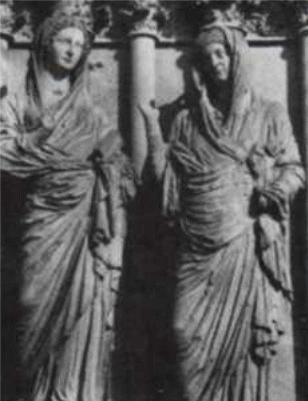 hese
figures are almost detached from their architectural background,
standing out from the column on pedestals.
hese
figures are almost detached from their architectural background,
standing out from the column on pedestals.
In «The Visitation» both the Virgin Mary and her kinswoman, Elizabeth, lean primarily on one leg, their upper bodies turned toward each other. The older Elizabeth has a wrinkled face, full of character, and drapery is handled with more imagination than before.
S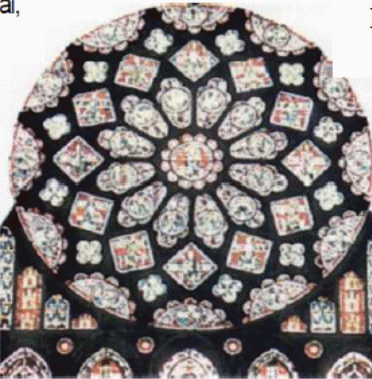 tained
glass. Chartres Cathedral was the
visible soul of the Middle Ages. Its stained glass windows, the most
intact collection of medieval glass in the world, measure 26,900
feet in total area. Illustrating the Bible, the lives of saints,
even traditional crafts of France, the windows are like a gigantic,
glowing, illuminated manuscript.
tained
glass. Chartres Cathedral was the
visible soul of the Middle Ages. Its stained glass windows, the most
intact collection of medieval glass in the world, measure 26,900
feet in total area. Illustrating the Bible, the lives of saints,
even traditional crafts of France, the windows are like a gigantic,
glowing, illuminated manuscript.
Tapestry. Weavers in the Middle Ages created highly refined tapestries, minutely detailed with scenes of contemporary life. Large wool-and-silk hangings, used to cut drafts, decorated stone walls.

